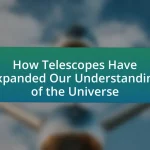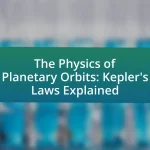The Tuning Fork Diagram of Galaxy Classification is a visual tool developed by Edwin Hubble in 1926 that categorizes galaxies into three primary types: elliptical, spiral, and irregular. This classification system is based on morphological characteristics and illustrates the evolutionary relationships among different galaxy types. The article explores the development of the diagram, the contributions of key astronomers, its significance in understanding galaxy formation and evolution, and its limitations compared to other classification methods. Additionally, it discusses best practices for applying the diagram in contemporary astronomy and highlights common mistakes to avoid in galaxy classification.

What is the Tuning Fork Diagram of Galaxy Classification?
The Tuning Fork Diagram of Galaxy Classification is a visual representation that categorizes galaxies based on their morphological characteristics. Developed by Edwin Hubble in 1926, the diagram illustrates a classification system where galaxies are divided into three main categories: elliptical galaxies, spiral galaxies, and irregular galaxies. The diagram resembles a tuning fork, with elliptical galaxies on one prong, spiral galaxies on the other, and irregular galaxies at the base, highlighting the evolutionary relationship between these types. Hubble’s classification system is foundational in astronomy, providing a framework for understanding galaxy formation and evolution.
How was the Tuning Fork Diagram developed?
The Tuning Fork Diagram was developed by Edwin Hubble in 1926 to classify galaxies based on their morphological characteristics. Hubble’s diagram visually represented galaxies as a branching structure, categorizing them into three main types: elliptical, spiral, and irregular. This classification system was grounded in observational data collected from telescopes, which allowed Hubble to analyze the shapes and structures of various galaxies. The Tuning Fork Diagram has since become a foundational tool in astronomy for understanding galaxy evolution and classification.
Who were the key astronomers involved in its creation?
The key astronomers involved in the creation of the Tuning Fork Diagram of Galaxy Classification are Edwin Hubble and Paul W. Hubble. Edwin Hubble developed the diagram in the 1920s to classify galaxies based on their shapes, introducing the concepts of elliptical and spiral galaxies. Paul W. Hubble contributed to the refinement of these classifications and the understanding of galaxy morphology. Their work laid the foundation for modern astronomical classification systems, which are still in use today.
What historical context led to the need for galaxy classification?
The historical context that led to the need for galaxy classification was the advancement of observational astronomy in the late 19th and early 20th centuries. As telescopes improved, astronomers like Edwin Hubble began to identify and categorize different types of galaxies based on their morphological features. Hubble’s work in the 1920s culminated in the development of the Tuning Fork Diagram, which organized galaxies into distinct categories such as elliptical and spiral, reflecting their shapes and structures. This classification was essential for understanding the universe’s composition and evolution, as it allowed astronomers to systematically study the properties and behaviors of various galaxy types.
What are the main components of the Tuning Fork Diagram?
The main components of the Tuning Fork Diagram are elliptical galaxies, spiral galaxies, and irregular galaxies. The diagram visually represents the classification of galaxies based on their shapes and structures, with elliptical galaxies on one end, spiral galaxies in the middle, and irregular galaxies on the other end. This classification system, introduced by Edwin Hubble in 1926, helps astronomers categorize galaxies and understand their evolution and characteristics.
What types of galaxies are represented in the diagram?
The types of galaxies represented in the diagram are elliptical galaxies, spiral galaxies, and irregular galaxies. The Tuning Fork Diagram, developed by Edwin Hubble, categorizes galaxies based on their shapes and structures, with elliptical galaxies characterized by their smooth, featureless light profiles, spiral galaxies featuring distinct arms winding outward from a central bulge, and irregular galaxies lacking a defined shape. This classification system is widely accepted in astronomy, providing a clear framework for understanding the diversity of galaxy forms.
How are the galaxies categorized within the diagram?
Galaxies are categorized within the Tuning Fork Diagram based on their morphological characteristics, primarily into three main types: elliptical, spiral, and irregular galaxies. Elliptical galaxies are represented on one side of the diagram, characterized by their smooth, featureless light profiles and lack of structure. Spiral galaxies, which include barred spirals, are depicted on the opposite side, showcasing distinct arms and a central bulge. Irregular galaxies, lacking a defined shape, are positioned outside the main categories. This classification system, developed by Edwin Hubble in 1926, provides a visual representation of galaxy evolution and structure, allowing astronomers to understand the relationships between different galaxy types.
Why is the Tuning Fork Diagram important in astronomy?
The Tuning Fork Diagram is important in astronomy because it provides a systematic classification of galaxies based on their morphological features. This diagram, introduced by Edwin Hubble in 1926, categorizes galaxies into three main types: elliptical, spiral, and irregular, facilitating the understanding of galaxy evolution and structure. The classification helps astronomers identify relationships between different galaxy types and their formation processes, supported by observational data that shows a correlation between galaxy morphology and other properties such as luminosity and star formation rates.
What insights does it provide about galaxy evolution?
The Tuning Fork Diagram of Galaxy Classification provides insights into the morphological evolution of galaxies, indicating how their shapes and structures change over time. This classification system, developed by Edwin Hubble, categorizes galaxies into elliptical, spiral, and irregular types, reflecting their evolutionary pathways. For instance, the transition from spiral to elliptical galaxies suggests a process of merging and interaction, which can lead to the loss of gas and star formation activity. Additionally, studies show that the distribution of galaxy types in the universe correlates with cosmic time, revealing that earlier epochs favored irregular and spiral forms, while later times exhibit a higher prevalence of elliptical galaxies. This pattern supports the theory that galaxy evolution is influenced by environmental factors and interactions, shaping the diversity of galaxy structures observed today.
How does it aid in the study of galaxy formation?
The Tuning Fork Diagram aids in the study of galaxy formation by providing a systematic classification of galaxies based on their morphological characteristics. This classification allows astronomers to analyze the relationships between different galaxy types, such as spiral, elliptical, and irregular galaxies, which are crucial for understanding their formation processes. For instance, the diagram illustrates how spiral galaxies evolve from earlier forms and how environmental factors influence their development. Studies have shown that the distribution of galaxy types correlates with cosmic structures, indicating that the formation of galaxies is influenced by their surroundings, such as clusters and filaments in the universe. This morphological framework thus serves as a foundational tool for researchers to investigate the evolutionary pathways of galaxies and the underlying physical mechanisms driving their formation.

How does the Tuning Fork Diagram relate to other galaxy classification methods?
The Tuning Fork Diagram is a specific method for classifying galaxies that organizes them into a structured visual format based on their morphological characteristics. This diagram primarily relates to other galaxy classification methods, such as the Hubble sequence, by providing a clear framework that categorizes galaxies into elliptical, spiral, and irregular types, reflecting their evolutionary stages. The Tuning Fork Diagram enhances the Hubble classification by illustrating the relationships between different galaxy types and their transitions, thereby offering a more nuanced understanding of galaxy morphology and evolution. This relationship is supported by the historical context in which Edwin Hubble developed the original classification scheme, which the Tuning Fork Diagram builds upon to incorporate additional complexities in galaxy structure.
What are the differences between the Tuning Fork Diagram and other classification systems?
The Tuning Fork Diagram differs from other classification systems by providing a visual representation that categorizes galaxies based on their morphological features and evolutionary relationships. Unlike traditional systems, which may rely solely on specific characteristics like size or brightness, the Tuning Fork Diagram emphasizes the connection between galaxy types, illustrating a continuum from elliptical to spiral galaxies. This diagram effectively organizes galaxies into a structured format, allowing for easier understanding of their development and classification. The diagram’s design facilitates the identification of transitional forms, which is often overlooked in other classification systems that may categorize galaxies more rigidly without considering their evolutionary pathways.
How has the Tuning Fork Diagram influenced modern astronomy?
The Tuning Fork Diagram has significantly influenced modern astronomy by providing a systematic framework for classifying galaxies based on their morphological characteristics. This diagram, introduced by Edwin Hubble in 1926, organizes galaxies into distinct categories such as elliptical, spiral, and irregular, facilitating clearer communication and understanding among astronomers. The classification system has been foundational in guiding observational studies and research, allowing astronomers to categorize and analyze galaxy properties, distribution, and evolution effectively. Furthermore, the Tuning Fork Diagram has been instrumental in the development of subsequent astronomical theories and models, including the understanding of galaxy formation and the large-scale structure of the universe.

What are the limitations of the Tuning Fork Diagram?
The limitations of the Tuning Fork Diagram include its oversimplification of galaxy classification and its inability to account for the diversity of galaxy morphologies. The diagram primarily categorizes galaxies into three main types: elliptical, spiral, and irregular, which can lead to a loss of nuanced understanding of galaxy features. Additionally, it does not effectively represent the evolutionary processes that galaxies undergo, nor does it incorporate the influence of environmental factors on galaxy formation. These limitations highlight the need for more comprehensive models that can better capture the complexity of galaxy structures and their development over time.
What criticisms have been made regarding its use?
Criticisms regarding the use of the Tuning Fork Diagram of Galaxy Classification include its oversimplification of galaxy morphology and the lack of consideration for evolutionary processes. Critics argue that the diagram, which categorizes galaxies into distinct shapes, fails to account for the complexities and variations observed in real galaxies. For instance, the classification does not adequately represent irregular galaxies or the transitional forms between categories, leading to potential misinterpretations of galaxy evolution. Additionally, some astronomers contend that the diagram’s rigid structure does not reflect the dynamic nature of galaxies, as many exhibit features that span multiple categories. This has been highlighted in studies such as those by Hubble himself, who acknowledged the limitations of his classification system in capturing the full diversity of galaxy forms.
How do these limitations affect galaxy classification?
Limitations in observational data and classification criteria significantly impact galaxy classification by leading to misclassifications and incomplete categorizations. For instance, the Tuning Fork Diagram, which organizes galaxies into spiral, elliptical, and irregular types, relies heavily on visual morphology. If observational data is limited by factors such as resolution or light pollution, galaxies may be inaccurately classified, resulting in a skewed understanding of their true nature. Additionally, the reliance on specific morphological features can overlook important physical properties, such as star formation rates or chemical composition, which are crucial for a comprehensive classification. This can lead to a misunderstanding of galaxy evolution and dynamics, as evidenced by studies showing that galaxies previously classified as elliptical may actually exhibit spiral characteristics when observed with advanced imaging techniques.
What alternative methods have been proposed to address these limitations?
Alternative methods proposed to address the limitations of the Tuning Fork Diagram in galaxy classification include the use of machine learning algorithms and multi-wavelength observations. Machine learning techniques, such as convolutional neural networks, can analyze large datasets more efficiently than traditional methods, allowing for more nuanced classifications that consider various morphological features. Multi-wavelength observations provide a comprehensive view of galaxies by integrating data from different parts of the electromagnetic spectrum, which can reveal structural and compositional details that the Tuning Fork Diagram may overlook. These approaches enhance classification accuracy and offer deeper insights into galaxy evolution and characteristics.
How can astronomers effectively use the Tuning Fork Diagram today?
Astronomers can effectively use the Tuning Fork Diagram today to classify galaxies based on their morphological characteristics. This diagram, developed by Edwin Hubble, categorizes galaxies into three main types: elliptical, spiral, and irregular, allowing astronomers to systematically organize and study galaxy properties. By utilizing this classification system, astronomers can analyze the distribution of galaxies in the universe, understand their formation and evolution, and identify relationships between galaxy types and their environments. For instance, studies have shown that the Tuning Fork Diagram aids in recognizing the correlation between galaxy morphology and star formation rates, enhancing our understanding of cosmic evolution.
What best practices should be followed when applying the diagram?
When applying the Tuning Fork Diagram of Galaxy Classification, it is essential to ensure clarity in the classification criteria. This involves accurately identifying the morphological features of galaxies, such as their shape and structure, which are critical for proper categorization. Additionally, utilizing consistent observational data enhances the reliability of the classification process. Research indicates that adherence to standardized criteria, as outlined by Hubble’s original classification system, improves the accuracy of galaxy categorization (Hubble, 1926). Furthermore, incorporating advanced imaging techniques can provide more detailed insights into galaxy structures, thereby refining the classification outcomes.
What common mistakes should be avoided in galaxy classification?
Common mistakes to avoid in galaxy classification include relying solely on visual morphology without considering other characteristics, such as spectral data and environment. Visual classification can lead to misidentification, as galaxies may appear similar but have different underlying properties. For instance, elliptical galaxies can be confused with lenticular galaxies if only shape is considered, despite their distinct formation histories. Additionally, neglecting the effects of redshift can result in inaccurate classifications, as the observed properties of distant galaxies can be altered by their motion relative to Earth. Accurate classification requires a comprehensive approach that integrates multiple data sources, ensuring a more reliable understanding of galaxy types.




